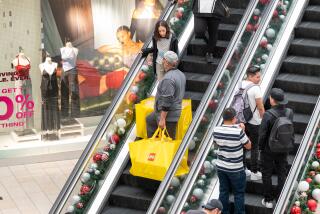Your friends’ social media posts are making you spend more money, researchers say

American families don’t save money like they used to. In 2018 the personal saving rate hovered somewhere around 7%. That’s up from an all-time low of 3% right before the Great Recession hit, but it’s well below the rate of a few decades ago.
There are a lot of potential explanations for this. Wage growth has slowed while necessities such as housing and medical care have grown more expensive, taking a big chunk out of personal income. The rise of easy credit has made spending beyond our means easier than ever. Pension plans have been replaced by 401(k)s, which are much easier to draw down in a pinch — even if it’s nearly always a bad idea.
Now, a team of U.S. and Canadian economists have proposed a new explanation for the declining savings rate, one rooted in individual psychology. At its heart lies a simple observation: Spending is a lot more visible to others than not spending. Changes in the media landscape have made other people’s spending more visible than ever. That, in turn, is making all of us spend even more — and save even less.
Humans are social creatures, and we have a tendency to evaluate our own standing in life relative to how our friends and neighbors are doing. We want to keep up with the Joneses, and stay ahead of the Smiths. Because of this, when we see other people spending money we have a tendency to believe that we can — or should — be spending too.
“A boat parked in a driveway draws the attention of neighbors more than the absence of a boat,” the economists explain in a new working paper. “Similarly, it is more noticeable when a friend or acquaintance is encountered eating out or reports taking an expensive trip than when not, or buys an enjoyable product as compared with not doing so.”
These signals from other people are particularly powerful in part because many of us have considerable uncertainty about how much we should be spending. “There is a great deal of evidence suggesting that people are indeed often ‘grasping at straws’ in their savings decisions, which suggests that they may look to social cues for help,” the authors write.
David Hirshleifer, a UC Irvine professor who is one of the authors, said via email that “saving is the flip side of consuming, and it’s tempting to think that you’re saving enough because you are not throwing lavish parties or taking expensive cruises the way some people you know are.” But, he warned, “such self-congratulation is treacherous, because those cruises and parties may not really be typical of your acquaintances — they just stand out in memory.”
Fifty years ago, our frames of reference for our spending habits were relatively small. We had our neighbors and friends, of course, as well as people we interacted with at work. But that’s all changed. Television brought us things like “Lifestyles of the Rich and Famous,” the Home Shopping Network and eventually reality TV shows where contestants are jetted off to tropical islands to enjoy expensive meals.
Next came the internet, with the discussion forums and specialist websites, where — as the authors tell it — postings about cool new product purchases “are more interesting, and therefore more likely to occur, than a posting to announce the news that the individual did not buy anything today.”
Now we have social media. We can log on to watch kids unbox expensive new toys on YouTube. Facebook lets us stay in touch with our rich college classmates who always seem to be on vacation. We can create and share detailed logs of the stuff we consume at sites like Yelp and TripAdvisor. We can see what our co-workers ate last night on Instagram.
On social media, as the authors tell it, “a posting about a consumption event triggers a notification to friends; a non-posting about not engaging in a consumption event does not.”
The net effect of this saturation of consumptive media is that we’re bombarded every day with signals to consume, consume, consume — and that’s before you even stop to consider the rise of an entire industry, advertising, devoted to parting people from their money. “People infer that low saving is a good idea,” as the authors put it.
A good deal of the paper is devoted to developing a sophisticated mathematical model to explain exactly how this process of consumption contagion works. One of the implications of their research is that finding ways to make non-spending more visible might help individuals develop more realistic views of overall spending and saving behavior.
“To decide if you’re overconsuming, make a special effort to notice when your friends do something that is frugal, such as having a staycation or holding on to their 15-year-old car,” Hirshleifer said. “If you’re going to compare yourself to others, try to make it realistic.”
More to Read
Inside the business of entertainment
The Wide Shot brings you news, analysis and insights on everything from streaming wars to production — and what it all means for the future.
You may occasionally receive promotional content from the Los Angeles Times.










